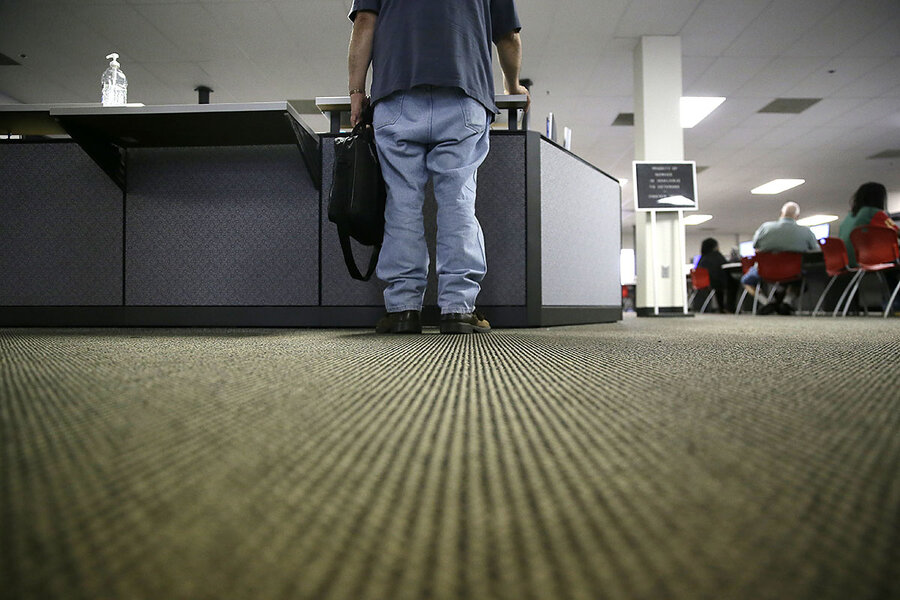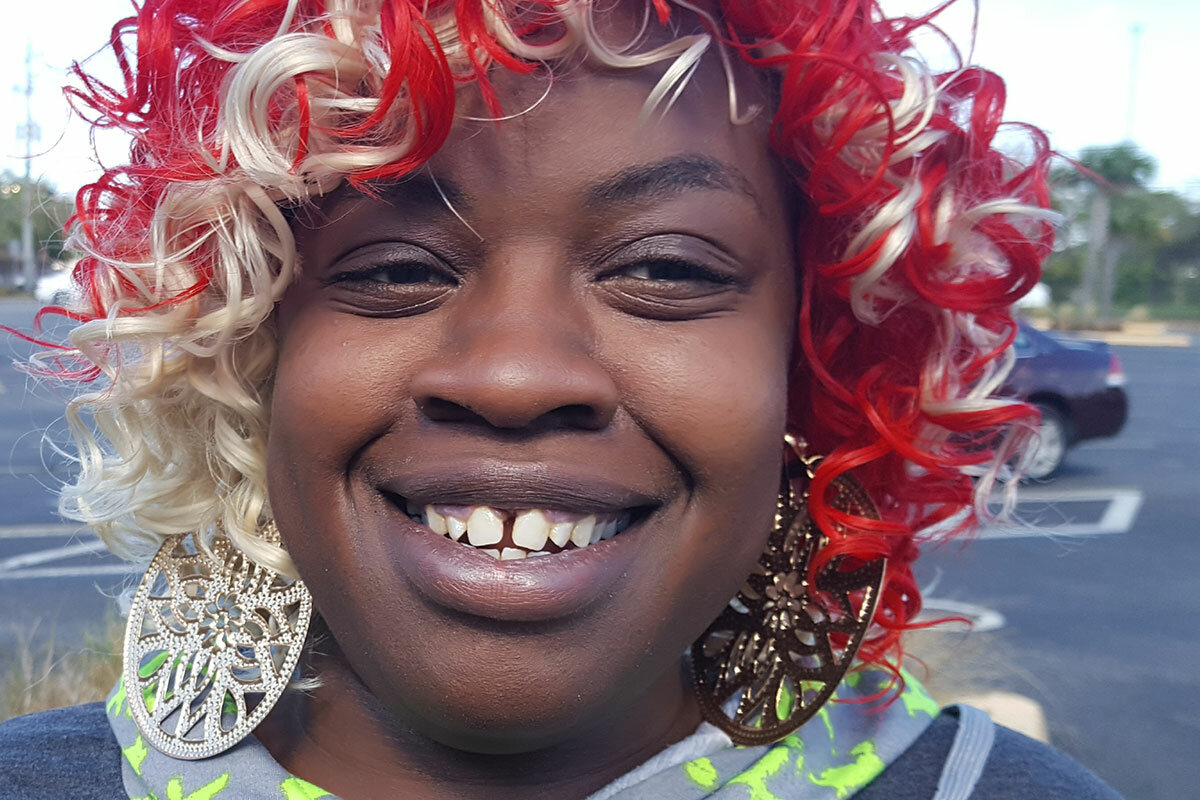In good times, safety net for the jobless frays
Loading...
| Jacksonville, Fla., and Boston
Jennifer Barkley looks down and apologizes for her sneakers, which are missing their laces. A well-worn polyester dress whips about her legs.
It’s been a long day, and Ms. Barkley is headed home, jobless and frustrated. A call center operator in Jacksonville, Barkley has been let go three times in the past year after big corporations like Bank of America changed contractors. Since these redundancies were no fault of her own, she’s eligible for unemployment benefits, which means she’s a regular at CareerSource Florida, a state agency which has a branch here in a strip-mall office next to a Halloween-themed amusement park.
Life on the dole in Florida isn’t easy street: Barkley’s benefits come to $270 a week and max out at three months. The cost of living may be low in Florida, but it’s not that low, so she’s cutting back, like trading in her Infiniti for a dented Hyundai with better mileage. “You have to be an exceptional budgeter to make it on unemployment,” she says.
Still, at least Barkley’s getting some income, giving her breathing space to find a similar job or switch careers. Across the nation, only 1 in 4 unemployed workers are receiving benefits, as Republican-run states like Florida have made the benefit both harder to claim and shorter in duration. A decade ago, 36 percent of jobless workers were getting benefits, and workers had up to six months to find a new job.
At a time of rock-bottom unemployment, this may seem almost irrelevant. Weekly jobless claims recently hit a low not seen since 1969. Although restrictive rules are discouraging some claims, a far bigger reason is the hottest job market since the late 1990s.
The reality, though, is that even in good times the job market includes the churn of layoffs as well as hires. In the most recent week some 229,000 people filed new claims for unemployment insurance (UI). And when the next downturn comes, the safety net will be all the more important. Typically, that’s when UI adds income that not only helps individuals but also helps the wider economy prevent a vicious spiral in which job losses beget more job losses.
“How responsive is this program going to be when the inevitable next recession happens?” asks George Wentworth of the National Employment Law Project, a union-backed think tank in New York, who previously ran Connecticut’s UI program. “It’s regarded amongst the most effective of economic stimulus programs,” he explains, because the jobless usually “spend all they receive in benefits and put it back into the local economy.”
Extra time can mean a better next job
Another reason to provide a financial cushion for laid-off workers: Taking the first job that comes along may not be a smart career move. For skilled workers in industries that are being reshaped by globalization, UI benefits can allow them to retrain and refine their job search so they can replace their lost income.
That said, extended benefits that keep workers out of the labor force too long can make it hard to match them with jobs. Long-term unemployment is also associated with poor health and depression; work is more than just a paycheck for many Americans.
For this reason, you probably don’t want insurance to replace all lost wages, says Christopher O’Leary, a senior economist at the W.E. Upjohn Institute for Employment Research in Kalamazoo, Mich. Researchers have found that the sweet spot between giving laid-off workers enough to sustain themselves and their families, but not enough that it becomes a disincentive to go back to work, is between 50 and 80 percent of average wages. “Very few states meet those standards,” he says.
Limits can change with the economy
In Florida, UI duration is pegged to the state’s unemployment rate: When the rate is low, as it is now, workers have 12 weeks to find another job. The state’s online claims system has also drawn complaints for its complexity and its higher rate of rejections and disqualifications.
Kimberly Wesley, a 30-something single mom with four kids, grew up in Jacksonville's Brentwood neighborhood, just north of the urban core. After living in San Diego, she recently moved back to be closer to family. But her experience of trying to make a buck in Florida, and what happens when a job runs out, has soured her on the move.
After losing her cook's job two months ago, she applied for unemployment benefits – and never heard back. So one recent day, on the hopes that a check may be waiting for her, she stopped in at CareerSource to check its status. Instead of a benefit, she was told the file had been closed. She had never been notified.“It is a joke,” she says.
The backstory was this: Ten years ago, after having her first two kids in Florida, she applied and was given a $200 emergency cash assistance. She attended one of the requisite classes, but stopped when she quickly found another job. But her failure to finish her class led to a sanction that remained on her record.
“I get the struggle, I've been there, and I get that people come to Florida for the low cost of living,” she says. “But you get what you pay for.”
Unemployed but not getting help
In a report that compares eligibility rates, the National Employment Law Project cited Florida as the stingiest state, with less than 1 in 10 unemployed workers receiving benefits in 2016. The highest eligibility rate was in Massachusetts, where 54 percent were UI recipients.
Florida isn’t the only state with such austerity. Since the Republican wave election of 2010, nine states have cut the maximum weeks of benefits available to jobless workers, ending a decades-old consensus of 26 weeks. The other states are Michigan, Missouri, South Carolina, Florida, Georgia, North Carolina, Kansas, Arkansas, and Idaho. (And the state-level rules, if a state’s economy is struggling, the federal government kicks in money for extended benefits that can last an additional 13 weeks – sometimes more.)
Among the steepest cuts have come in North Carolina, where a typical laid-off worker only receives nine weeks of benefits worth $247, compared to a national average of $332, according to the Urban Institute.
The argument for cutbacks
Legislators in North Carolina argued that overly generous UI programs can stifle self-reliance and that cutting the rolls means lower taxes on employers, thus making their state more attractive to businesses. States have also framed their cuts to benefits as prudent and a way to rebuild reserves that were tapped out in 2009. In all, 36 states had to borrow from the federal government after their UI reserves ran out.
For workers who have jobs, UI cuts may be the dog that didn’t bark. But for Will Adams, it’s the dog that barked that landed him in his current predicament.
On a recent afternoon, Mr. Adams, a 20-something resident of Jacksonville, strolls his daughter Ruby through the Goodwill next to the career center that handles UI claims. He’s spending the few dollars he has on some clothes for her. But despite being jobless he has no plans on going next door to see if he qualifies for benefits.
His last job at a veterinarian's office didn’t end well. One of the two pit bulls he was returning to their owner in the waiting room panicked and bit another dog owner in the leg. “Let's just say I didn't last long after that,” he says.
“But, I mean, it wasn't my fault. The waiting room was full of people and dogs. These dogs were 100 pounds a piece. They got scared. I couldn't control them.”
In Florida, as elsewhere, a worker has to lose a job through no fault of his or her own before making a claim. Adams reckons his own chances are slim. Asked if he thinks he’ll receive help from the state government if his unemployment woes linger, he shakes his head. “I don't think the state will ever have my back,” he says.






